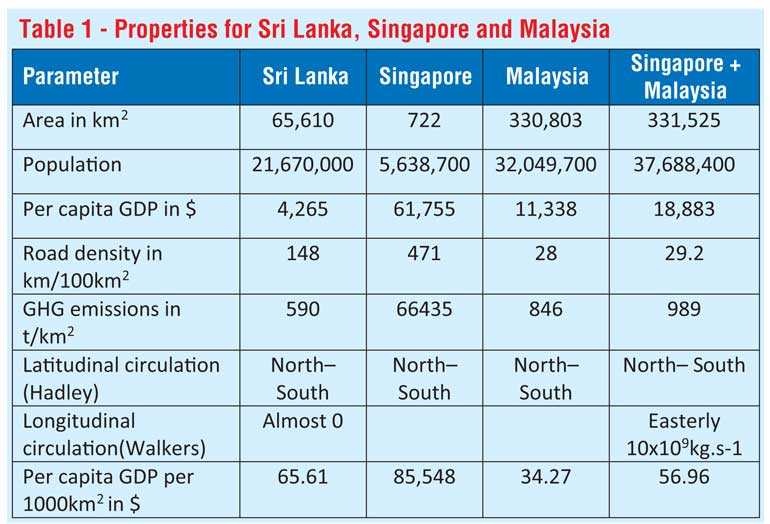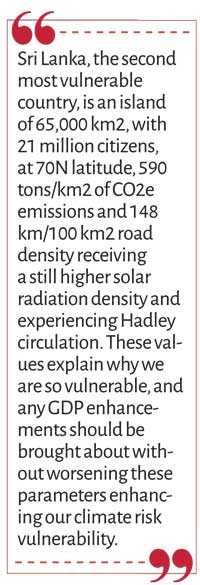Sunday Oct 19, 2025
Sunday Oct 19, 2025
Tuesday, 28 May 2019 00:00 - - {{hitsCtrl.values.hits}}

Introduction
We are eternally looking at our growth figures using Gross Domestic Product per capita and currently at $ 4,265 tell ourselves that we are still in the lower middle income country group and need to work hard to jump over to upper middle income country group and then to higher income country group. We respect our national leaders’ eagerness to provide a better future for younger Sri Lankans and sincerely hope that their attempts will result in fulfilment of their aspirations.
I was still thinking that per capita GDP was a worthwhile parameter to follow and base our development strategies on, when I came across the German Watch’s latest (2019) Climate Risk Index Ratings and we had become the 2nd most vulnerable country in the world. And to my surprise, Puerto Rico, a country with per capita GDP of $ 32,000 was identified as the worst at No. 1 slot. This again is an island nation, but in the Caribbean’s, with three million people occupying 9,000 square kilometres. It lost almost its entire infrastructure during 2017 due to two hurricanes named Irma and Maria. The country is engaged in petrochemical, pharmaceuticals, electronic, real estate, finance, insurance, tourism, and MICE industries, etc. All this, almost, got devastated in about a month and a half.
This made me relook at the validity of following one’s economic development using per capita GDP values.
Killer in the per capita GDP
I started wondering whether value of $ 32,000 for per capita GDP was too much to be maintained for Puerto Rico. The country has a GHG emission rate of 3,110 tons of CO2e/km2 and a road density of 289 km/100 km2. It is at 180N and subjected to high levels of solar radiation density and Hadley circulation.
Sri Lanka, the second most vulnerable country, is an island of 65,000 km2, with 21 million citizens, at 70N latitude, 590 tons/km2 of CO2e emissions and 148 km/100 km2 road density receiving a still higher solar radiation density and experiencing Hadley circulation. These values explain why we are so vulnerable, and any GDP enhancements should be brought about without worsening these parameters enhancing our climate risk vulnerability.
It may be worthwhile to mention here the pre-requisites for enhanced global warming. It needs enhanced greenhouse gas quantities in atmosphere to reflect more of terrestrial radiation from below. One major component of terrestrial radiation from below is what emanates as longwave radiation from local roadways due to absorption of 88-94% of solar radiation. So, when we increase road density and vehicular traffic on same, both these factors are increased simultaneously leading to enhanced climate risk vulnerability. It is this increase of road density and GHGs emitted that made Sri Lanka which was about the 98th in climate risk vulnerability listings for a decade or so jump to be the 4th and then the 2nd in consecutive listings.
I was trying to workout possible avenues to economic development within this framework, when I came across a writeup which mentioned about Australia enjoying a per capita GDP of $ 59,655. I was flabbergasted by this and I tried to understand how Australia which hosts a fair percentage of my own engineering faculty batchmates could be having such a high per capita GDP value. I remembered how even the Friday on which Melbourne (horse racing) Cup was held in 1988 was a holiday. That was when I spent about three weeks visiting almost all gold mines in Western Australia providing technical support on use of Haycarb’s activated coconut shell carbon in carbon-in-pulp process in gold mines there. Then I remembered the resources they have and their large landscape.
Then I looked at Australia’s land area and found it to be 7,692,024 km2 with about 25,324,000 inhabitants. And I calculated their per capita GDP per 1000km2 to find it to be only $ 7.75 per 1000km2 per capita. So, when I calculated corresponding value for Sri Lanka, it turned out to be $ 65.61 per 1000km2 per capita. Obliviously we are doing 8 times better with the area we have inherited with even lesser natural resources in the form of gold mines, coal, natural gas, etc. Should not we be proud about our achievements?
Then I felt sorry for the poor Puerto Ricans who with their 3,000 m2 per person land area and no other special mineral resources tried to follow others like Australia with 303,744 m2 per person and gold, etc. or USA with about 30,056 m2 per person again with gold in Nevada, etc. For them the location was also against them; being close to the equator and on paths of major cyclones which get attracted there due to Hadley Circulation.
Economists generally identify three objectives of development as (a) increase availability and widen distribution of basic life-sustaining goods, (b) raise levels of living and (c) expand the range of economic and social choices. Obviously, the sheer physical size of a country and the size of its population are considered as important determinants of its economic potential and major factors differentiating one developing nation from another. Had Puerto Rico exceeded its limit for possible economic development?
Why Singapore is spared
Of course, there will be those Lee Kwan Yew followers who would quote that small City State Singapore with 128 m2 per person achieving a per capita GDP of $ 85,548 per 1,000 km2. My response to that is Singapore is lucky in the sense that nature – large scale circulations – is unable to differentiate between Singapore and other parts of land mass there. For these large scale circulations, it is a single land mass and when it is considered in that manner, they, Malaysia and Singapore demonstrate a combined per capita GDP of only $ 56.96 per 1,000 km2. So they are, collectively, slightly worse than us, Sri Lankans.
If we look at Malaysia and Singapore together their collective road density and GHG emissions per unit area would be as follows. Collective road density will be 29.2 km/100 km2 and collective GHG emission will be 989t/km2. From these, it could be seen that although the GHG emission is very high, the road density is not high enough to emit adequate long wave radiation for the region to face climate risk vulnerability. Please see table 1.
While GHGs do get diluted due to circulations and absorption by vegetation and the oceans, increased Long Wave Radiation from increased road densities do not get diluted and will definitely lead to enhanced global warming.
All this shows why Sri Lanka is far more vulnerable than Singapore-Malaysia combination.
Strategies for enhancing our GDP
It is this understanding which Prof. Joseph Stiglitz expressed when he recommended that we establish a Green Economy in Sri Lanka. Obviously, he, the experienced Nobel Prize winner in Economics, did not need to do all these computations, the way I had to.
Neither our political leadership, nor our economists took any notice of it – probably none of them understood it. It is this understanding which prompted us to write on ‘Positive balance of trade: dream to reality’ to Daily FT on 14 August 2014, suggesting that we indulge in a Green Economy as a move towards making our balance of trade positive. That was before Prof. Stiglitz’s visit and at least one thought leader opined that a positive balance of trade was not a parameter to be pursued.
In that article, we said that this period is the time during which both automobile and energy industries are going through revolutionary changes and hence the appropriate time to carve out decent fractions of the two by being one of the first comers. This is the type of approach suggested by UNEP in their document titled Green Economy put out in mid-2011.
Plotting future growth pathways
As such, our future growth pathways need to be through greener routes. The aforementioned findings put in two critical restrictions on our future growth pathways as follows: (a) Such pathways should neither increase greenhouse gas emissions nor reduce GHG absorption by our natural vegetation. (b) Such pathways should not increase our road density or associated pavings. This is the challenge for Sri Lankan economists of today. Not only for economists; but, also for those superior class business magnates and other development strategists who preach on how to make Sri Lanka a more prosperous country.
It is in this background we hear about Millennium Challenge Corporation (MCC) of USA planning to invest $ 450 million in Sri Lanka and (a) make our land more productive and (b) improve our roadwork related services. Of course, I can’t understand why MCC wants to improve our land productivity when our GDP per capita per 1000 km2 is $ 65.51 and theirs is a miserable $ 6.36. Obviously, I don’t mind them coming in after they surpass ours and that value is for a land which has not only coal; but also solid gold, liquid gold and even gaseous gold in the form of natural gas, etc.
On the other hand, just imagine what would happen to the Sri Lanka’s economy, if they use their levels of productivity as the benchmark and make our economy to yield $ 6.36 per capita per 1,000 km2. What is the guarantee the Government has, that this would not happen?
Then there is the Oil Refinery Project that been planned for Hambantota with assistance from Oman for which the foundation stone was laid on 24 March 2019. Imagine this being in the context of UNFCCC Committee President for COP 24, Michael Kurtyaka and Richard Harrington, Minister for Business and Trade, UK sending out a request to almost all participating governments to commence work on e-Mobility. 
This is how we respect a collective global initiative in the best interests of mankind. And we are the second most vulnerable country in the world. So, they are planning how to be the most vulnerable country with about 20,000 people dead due to natural disasters like hurricanes, cyclones, etc., the type of things which devastated Puerto Rico.
This is in a global environment where country after country is setting target years by which they would have all transportation completely converted to non-fossil fuel or electricity driven. This is in a global environment where even school children have got emancipated and carry out classroom strikes against climate change.
When this Government came to power, the Prime Minister sent some Senior Executives to Harvard Kennedy School in USA and it is Prof. Henry Lee of Harvard Kennedy School who first said that Battery Electric Vehicle will be the ultimate winner. There were a few options available in early 2011 which he evaluated in a detailed mathematical modelling exercise and he made that pronouncement and we expected that message from Prof. Lee would have been the basis of Sri Lanka’s future transportation plans.
On 27 June 2018, we wrote to Daily FT an article titled ‘Pre-requisite for economic prosperity: Tame the behemoth or get consumed by it’ showing that putting up an oil refinery is not good business because with vehicle electrification taking place all over the world, price differential between crude and refined oil would become less and less and as a result oil refining will not be good business. Fortune magazine also mentioned oil refining as an industry, in a list of twenty five, one should not indulge in, some years back, even before vehicle electrification has not reached its current levels.
More than anything else (a) this ignoring of our climate risk vulnerability rating by the highest levels of public policy making, (b) taking climate change impacting policy decisions in contravention of Climate Change Secretariat and UN pronouncements lead to the bitter conclusion that our Cabinet of Ministers is either completely ignorant of true nature of climate change or they don’t care about the future of Sri Lanka.
It is also interesting to note that when World Bank published its ‘Hot spots in South Asia’, it clearly indicated that Sri Lanka and Bangladesh are the most vulnerable countries in South Asia and one important – rather the most significant – characteristic which contributed to this was the road density.
What is a Green Economy?
Well it may be that it is we, that includes Prof. Joseph Stiglitz as well, who are to be blamed. We may not have expressly explained what a Green Economy is.
There are many ways of assessing whether an economy is green or not; but I believe that the Global Green Economy Index (GGEI) system offers the best approach to be adopted. It basically looks at a country’s commitment to a Green Economy through four aspects as follows: (i) Leadership and Climate Change, (ii) Efficiency Sectors, (iii) Markets and investments and (iv) Environment. Each one of these are broken down into specific parameters and quantitative ratings could be given which could be composited into a grand total according to which countries could even be listed.
While the 1st component gives 20% marks to the Head of State’s advocacy for green issues, it gives 50% to performance on climate change issues. Second component Efficiency Sectors looks at how energy efficiently buildings, energy, tourism, transport and waste recycling are being carried out and each is given equal weightage. The third component Markets and Investments look at Renewable Energy Investment Attractiveness, Cleantech Innovation, Corporate Sustainability and Green Investment Facilitation with each given equal weightage. In respect of Environment, the six parameters (a) Agriculture, (b) Air Quality, (c) Water, (d) Biodiversity and Habitat, (e) Fisheries, (f) Forests are considered with equal weightage.
Once we understand this framework, it is very easy to evaluate a project and decide whether we should promote it or drop it. Political leaders who still live in the 20th century would not be able to locate adequate and appropriate Green Economy projects.
In fact, in 2011 June, UNEP published a document called ‘Green Economy’ (this document is no longer available in Cyber space) which has been prepared with inputs from major financial consultancy firms in the world like Bloomberg, Ernst & Young, Deloitle & Touche, etc. It anticipated that mankind would spend about $ 1.3 trillion on the Green Economy comprising of $ 600 billion on energy, another $ 325 billion on transportation, etc. It also mentioned that if a country spends about 0.34% of its GDP annually on electro-mobility that country could achieve 80% penetration in 40 years while increasing employment in the country by 10%. This is what the financial wizards identified as possible at that time.
Then they can implement Highway Solarisation defined as ‘a dedicated infrastructure for powering Battery Electric Vehicles (BEVs) or the grid, using solar energy collected by laying PV solar panels along and above the highways’ to generate electricity on the highway itself.
The few aspects which were mentioned earlier throw a very serious challenge to the present day economists. They can’t be working out economic development pathways the same way they had been doing in the past. They need to bring in environmental dimensions of potential projects into the process much earlier than been done today.
Conclusion
Let us identify what our Global Green Economic Index (GGEI) is and let us identify projects which would only improve our GGEI and not those which would lower the index. Of course, one might ask us how to identify these projects and what I would suggest is that subject the new proposals for projects, whether at BOI or any other agency/ministry follow this route and such evaluations need to be transparent. Just like we keep EIA Reports available to the public for their comments, we need to keep the implications of GGEI ratings arising from new products, processes and projects also available to the public for comments.
We can use the GGEI to see how the Oil Refinery project and MCC Project would influence our environmental aspects. We shall not promote any project which increases our GHG emissions nor reduce GHG absorption by vegetation nor any projects which will increase road density unless there is Highway Solarisation implemented above such new roadways.
This is so because of our crucial position at the second place in respect of climate risk vulnerability ratings and these are the only two contributory factors over which we have control and the other two natural causes mentioned earlier are not controllable by us in Sri Lanka nor by any other set of human beings.
(The writer is Managing Director at Somaratna Consultants Ltd.)